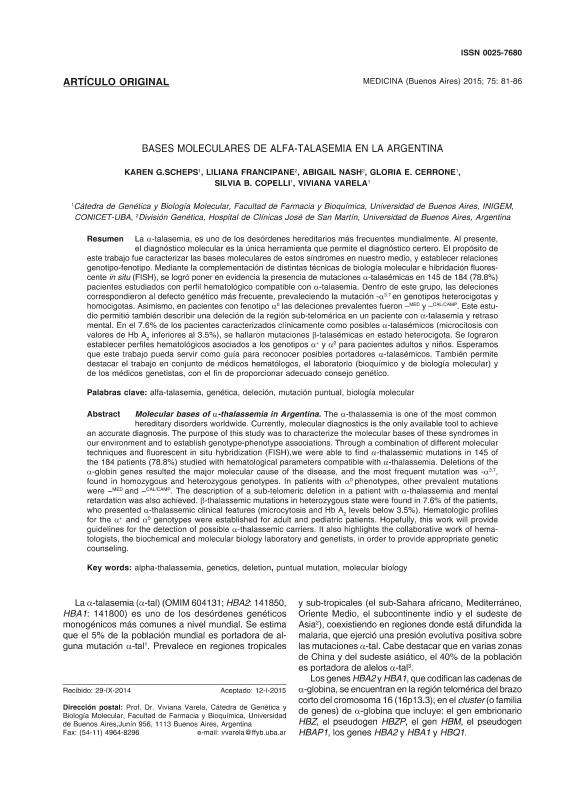Artículo
La α-talasemia, es uno de los desórdenes hereditarios más frecuentes mundialmente. Al presente, el diagnóstico molecular es la única herramienta que permite el diagnóstico certero. El propósito de este trabajo fue caracterizar las bases moleculares de estos síndromes en nuestro medio, y establecer relaciones genotipo-fenotipo. Mediante la complementación de distintas técnicas de biología molecular e hibridación fluorescente in situ (FISH), se logró poner en evidencia la presencia de mutaciones α-talasémicas en 145 de 184 (78.8%) pacientes estudiados con perfil hematológico compatible con α-talasemia. Dentro de este grupo, las deleciones correspondieron al defecto genético más frecuente, prevaleciendo la mutación -α3.7 en genotipos heterocigotas y homocigotas. Asimismo, en pacientes con fenotipo α0 las deleciones prevalentes fueron –MED y –CAL/CAMP. Este estudio permitió también describir una deleción de la región sub-telomérica en un paciente con α-talasemia y retraso mental. En el 7.6% de los pacientes caracterizados clínicamente como posibles α-talasémicos (microcitosis con valores de Hb A2 inferiores al 3.5%), se hallaron mutaciones β-talasémicas en estado heterocigota. Se lograron establecer perfiles hematológicos asociados a los genotipos α+ y α0 para pacientes adultos y niños. Esperamos que este trabajo pueda servir como guía para reconocer posibles portadores α-talasémicos. También permite destacar el trabajo en conjunto de médicos hematólogos, el laboratorio (bioquímico y de biología molecular) y de los médicos genetistas, con el fin de proporcionar adecuado consejo genético. The α-thalassemia is one of the most common hereditary disorders worldwide. Currently, molecular diagnostics is the only available tool to achieve an accurate diagnosis. The purpose of this study was to characterize the molecular bases of these syndromes in our environment and to establish genotype-phenotype associations. Through a combination of different molecular techniques and fluorescent in situ hybridization (FISH),we were able to find α-thalassemic mutations in 145 of the 184 patients (78.8%) studied with hematological parameters compatible with α-thalassemia. Deletions of the a-globin genes resulted the major molecular cause of the disease, and the most frequent mutation was -α3.7, found in homozygous and heterozygous genotypes. In patients with α0 phenotypes, other prevalent mutations were –MED and –CAL/CAMP. The description of a sub-telomeric deletion in a patient with α-thalassemia and mental retardation was also achieved. β-thalassemic mutations in heterozygous state were found in 7.6% of the patients, who presented α-thalassemic clinical features (microcytosis and Hb A2 levels below 3.5%). Hematologic profiles for the α+ and α0 genotypes were established for adult and pediatric patients. Hopefully, this work will provide guidelines for the detection of possible α-thalassemic carriers. It also highlights the collaborative work of hematologists, the biochemical and molecular biology laboratory and genetists, in order to provide appropriate genetic counseling.
Bases moleculares de alfa-talasemia en la Argentina
Título:
Molecular bases of α-thalassemia in Argentina
Scheps, Karen ; Francipane, Liliana; Nash, Abigail; Cerrone, Gloria Edith; Copelli, Silvia Beatriz; Varela, Viviana
; Francipane, Liliana; Nash, Abigail; Cerrone, Gloria Edith; Copelli, Silvia Beatriz; Varela, Viviana
 ; Francipane, Liliana; Nash, Abigail; Cerrone, Gloria Edith; Copelli, Silvia Beatriz; Varela, Viviana
; Francipane, Liliana; Nash, Abigail; Cerrone, Gloria Edith; Copelli, Silvia Beatriz; Varela, Viviana
Fecha de publicación:
04/2015
Editorial:
Medicina (Buenos Aires)
Revista:
Medicina (Buenos Aires)
ISSN:
0025-7680
e-ISSN:
1669-9106
Idioma:
Español
Tipo de recurso:
Artículo publicado
Clasificación temática:
Resumen
Palabras clave:
Alfa-Talasemia
,
Genética
,
Deleción
,
Mutación Puntual
,
Biología Molecular
Archivos asociados
Licencia
Identificadores
Colecciones
Articulos(INIGEM)
Articulos de INSTITUTO DE INMUNOLOGIA, GENETICA Y METABOLISMO
Articulos de INSTITUTO DE INMUNOLOGIA, GENETICA Y METABOLISMO
Citación
Scheps, Karen; Francipane, Liliana; Nash, Abigail; Cerrone, Gloria Edith; Copelli, Silvia Beatriz; et al.; Bases moleculares de alfa-talasemia en la Argentina; Medicina (Buenos Aires); Medicina (Buenos Aires); 75; 2; 4-2015; 81-86
Compartir



